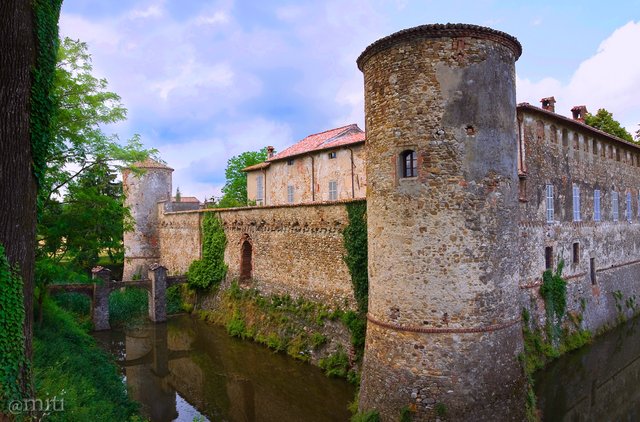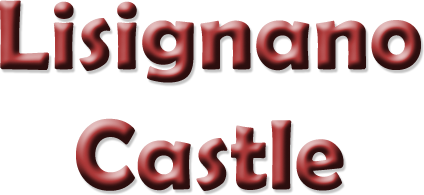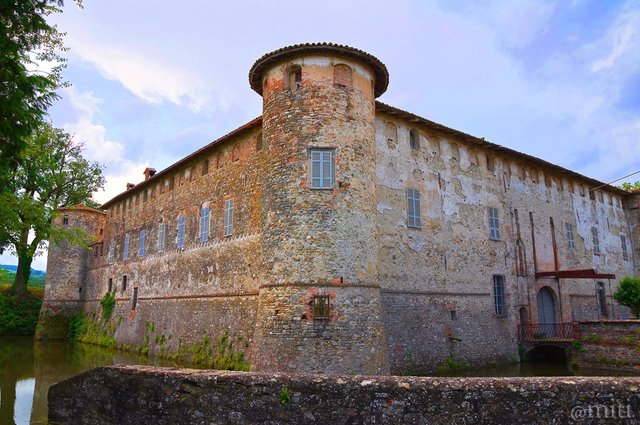A Journey through Italy: one photo every day #94 - LISIGNANO CASTLE [ENG/ITA]

The Castle of Lisignano (Author's photo - All rights reserved)
Il Castello di Lisignano (Immagine dell'autore - tutti i diritti sono riservati)



Ciao a tutti,
questo è un viaggio attraverso l'Italia. Posterò una foto al giorno con una brevissima descrizione. Spero vi piaccia!

Lisignano è un piccolo villaggio del Comune di Gazzola, in provincia di Piacenza, nella regione settentrionale italiana dell'Emilia Romagna. Sorge sulle rovine di un antico insediamento agricolo romano, nei pressi del sito dove ebbe luogo la battaglia del Trebbia con i Cartaginesi di Annibale.
Lisignano, anticamente nota come Licinianus, è citata nella Tabula Alimantaria Traianea, iscrizione romana in bronzo rinvenuta nei pressi di Velleia contenente numerosi dati relativi all'organizzazione agricola del territorio piacentino nel secondo secolo con indicazioni di nomi e località. Il villaggio era una sede parrocchiale principale durante l'età medievale.
Il castello di Lisignano viene menzionato per la prima volta in documenti ufficiali nel 1244 quando vi soggiornò il marchese di Hohenburg, vicario dell'imperatore Federico II. Il castello è probabilmente molto più antico.
Costruito nel XII secolo, esso è un eccellente esempio della trasformazione dei castelli feudali in residenze di campagna per famiglie nobili alla fine del Rinascimento. La costruzione è a pianta quadrata con quattro torri cilindriche circondate da un fossato nel quale scorre ancora oggi l'acqua del torrente Luretta.
Durante la fine del diciassettesimo secolo, gli interni del castello sono stati modificati per il nuovo stile di vita della nobiltà. La ristrutturazione, progettata da Ferdinando Galli, noto come Bibbiena, si trova sul lato est del cortile, coperto da elementi architettonici e affreschi che si aprono su un cortile ad arco, mentre a sud c'è un piccolo boschetto naturale con una statua di Ercole intento a uccidere il leone al centro.
Un ponte levatoio con di bolzoni in legno e catene conduce al castello.
Le prigioni erano situate nel livello inferiore di una delle torri. I condannati venivano calati per mezzo di funi attraverso una botola nel soffitto. Alcuni sostengono che vi sia un passaggio segreto sotto il torrente Luretta che conduce al Castello di Agazzano.
Come altre strutture fortificate della zona, nel corso dei secoli subì numerosi passaggi di mano. Appartenne ai Pagani, dal 1387 ai Figliagaddi, poi all’Ospedale Grande di Piacenza, e dal 1632 fino all’inizio del ventesimo secolo fu dei Rizzalotti.
Oggi è proprietà privata e non è aperto al pubblico.
Cosa vedere: Il comune di Gazzola è certamente tra i borghi più incastellati d’Italia. Oltre al più famoso castello di Rivalta se ne possono contare altri tre: il castello di Rezzanello, il castello di Momeliano, il castello di Lisignano.

Hello everyone,
I began a Photo Journey through Italy. I will post one photo every day with a little note of explanation. I hope you like it!

Lisignano is a small village of the Municipality of Gazzola, province of Piacenza, in the northern Italian region of Emilia Romagna. It arise on the ruins of an ancient Roman farming settlement, near the site where the battle of Trebbia with the Carthaginians of Hannibal took place.
Lisignano, formerly known as Licinianus, is mentioned in the Tabula Alimantaria Traianea, a bronze Roman inscription found near Velleia containing numerous data regarding the agricultural organizationof the Piacenza territory in the second century with indications of names and locations. The village was a main parish during the medieval ages.
The Castle of Lisignano is first mentioned in official documents in 1244 when Marquise Hohenburg, Vicar of Emperor Federico II, sojourned. The castle is however much older.
Built in the twelfth century, the castle is an excellent example of the transformation of feudal castles into country residences for noble families at the end of the Renaissance. The construction is square shaped with four cylindrical towers surrounded by a moat in which water from the Luretta stream still runs today.
During the late seventeenth century, the interiors of the castle have been modified for the new nobility lifestyle. The renovation, designed by Ferdinando Galli, known as Bibbiena, are found on the east side of the courtyard, covered with architectural elements and frescoes which open onto an arched courtyard, while to the south there is a small natural grove with a statue of Hercules killing the lion at the centre.
A draw-bridge with wooden rams and chains leads to the castle.
The prisons were located in the lower level of one of the towers. The condemned were lowered by means of ropes through a trap-door in the ceiling. Some claim that there is a secret passage under the Luretta stream which leads to the Castle of Agazzano.
Like many other fortifications of the area, the castle passed from one noble family to another through the centuries. The Pagani, from 1387 the Figliagaddi, the Grande Hospital of Piacenza, and from 1632 to the 20th Century it belonged to the Rizzalotti.
Today it is private property and is not open to the public.
Thing to see: The Municipality of Gazzola is no doubt one of the smaller towns of Italy with the highest concentration of castles. Aside from the famous Castle of Rivalta, there are three more: the Castle of Rezzanello, Castle of Momeliano and the Castle of Lisignano.

| Tipo di foto / Category | Paesaggio / Landscape view |
| Esposizione / Settings | 1/125 sec, ISO 200, f/9 |
| Camera | Nikon D5000 |
| Lente / Lens | Tamron SP 17-50mm f/2.8 XR Di II LD |
| Filtro / Filter | Polarizzatore Hoya / Hoya Polarizing filter |
| Cavalletto / Tripod | Manfrotto MKC3-P01 |
| Località / Location | Lisignano/Gazzola (Piacenza), Italia |
| Software | Photoshop / HDR |


The Castle of Lisignano (Author's photo - All rights reserved)
Il Castello di Lisignano (Immagine dell'autore - tutti i diritti sono riservati)
castle and moat? super cool, wish there are castles in NA
Yeah, very cool!
Congratulations, Your Post Has Been Added To The Steemit Worldmap!
Author link: http://steemitworldmap.com?author=miti
Post link: http://steemitworldmap.com?post=a-journey-through-italy-one-photo-every-day-94-lisignano-castle-eng-ita
Want to have your post on the map too?
What a lovely friend miti, and it makes it more beautiful to be in the stream, it gives a special touch. 😉
;-)
La nostra italia, piena di tesori e di cultura! Grazie a te che ogni giorno condividi queste bellissime foto!
Figurati, mi fa piacere mostrare le bellezze nascoste del nostro paese.
Cercherò di andarci. Grazie!
Se capiti in zona, potrai vedere anche altri castelli come quello di Rivalta e Rezzanello.
whoa i wonder how many castles there are in italy? one every day. they just dont get finish. but seriously they are somewhat extraordinry and special. thanks for sharing. keep up the good work @miti.
Thank you
Beautiful place. Italy has an incredible architectural heritage and so many castles! Similar in this respect to France (where I live in Normandy, there are castles everywhere too.)
Historically, Italy has a shared history with France. I woud like to go to your country, one day.
@miti bro where is " colosseo " in italy ??? its far away from you or near ?? i like this historic building plZ take some good snaps for us
It is in Rome, it's 300 miles out from my city.
You got a 33.54% upvote from @ocdb courtesy of @miti!
wow sir your all photo is admirable as usually
Thanks.